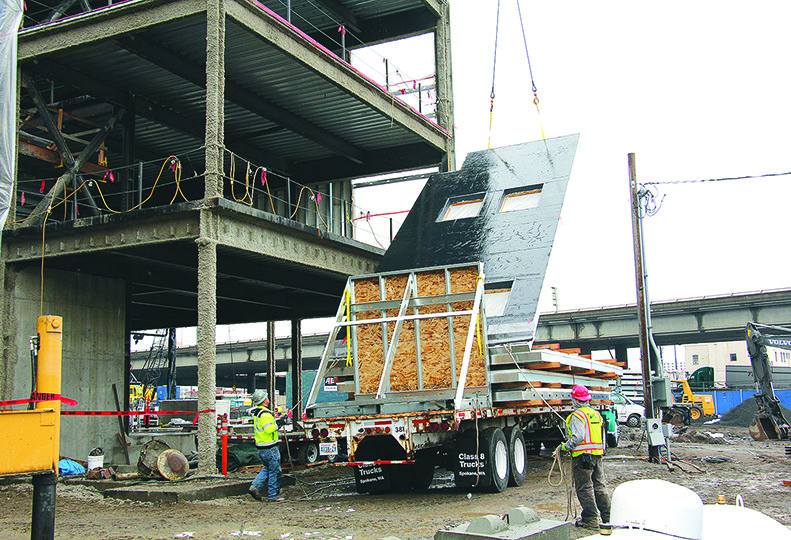
Home » Special delivery in construction
Special delivery in construction
Bouten, others use new approach designed to reduce inefficiencies, costs

November 22, 2017
The construction team that’s building a $34 million psychiatric hospital on the lower South Hill is using a collaborative method called integrated project delivery that the contractor involved says is expected to result in substantial savings in time, labor, and material costs.
Integrated project delivery, or IPD, emphasizes collaboration by all project-involved parties through every step of a project’s design and construction to optimize project efficiency, says Bill Bouten, president of Spokane-based Bouten Construction Co., the general contractor for the hospital project.
Bouten says the behavioral health hospital is the first IPD project in Eastern Washington that he’s aware of, though he says the approach has been used in other parts of the U.S.
The closest common construction delivery method to IPD is the design-build method, which focuses on strengthening the relationship between three main parties: an owner, a general contractor, and a main architect, says Bouten.
Bouten says he’s observed the industry moving toward a design-build method of construction delivery, which he thinks will lead to IPD growth in the long run.
“The design-build method is a step toward integrated project delivery,” he says.
IPD’s largest variation from the design-build model is its incorporation of all project-involved entities, including subcontractors, also referred to as trade partners, he says.
In the case of Spokane’s envisioned new behavioral health hospital, he says, 13 parties signed the same contract and are involved in all project meetings.
In addition to the project owner, contractor, and Spokane-based NAC Architecture, the main architect, the signatory parties are: Boulder Associates, of Boulder, Colo.; Buehler & Buehler Structural Engineers Inc., of Sacramento, Calif.; DCI Engineers Inc., of Spokane; Mackin & Little Inc., of Spokane; MJM Grand Inc., of Airway Heights; MSI Engineers, of Spokane; NAC Engineering, of Spokane; Performance Contracting Inc., of Spokane; Summit Electric LLC, of Post Falls; and Temp-Control Mechanical Corp., of Kennewick, Wash.
Brian R. Sayler, project executive and senior project manager with Bouten Construction, says, “We are all sharing the profit, and we are all sharing the risk.”
Sayler says the three-story, 67,000-square-foot building will include 100 patient beds, group therapy rooms, a gymnasium, two outdoor courtyards, a kitchen, and a dining room. It’s being erected at 104 W. Fifth, the former site of the Fifth & Browne Medical Center, which was razed to make way for the hospital.
Bouten Construction broke ground May 1 on the project, and it’s expected to be completed in summer 2018.
The hospital is a joint venture between Fairfax Behavioral Health, of Kirkland, Wash., and Renton, Wash.-based Providence St. Joseph Health. Fairfax Behavioral Health is a subsidiary of Universal Health Services Inc., of King of Prussia, Pa.
In general, in the construction industry, one of the most common conventional approaches to construction delivery is the design-bid-build method, Sayler says.
He says the design-bid-build method operates in a linear fashion in which the owner describes the project to be built, and the architect designs it. The project then is put out to bid, and a contractor—often the one that submits the lowest bid—is selected to build the project.
“By nature (the design-bid-build model) has a lot of contention because contractors are looking for holes in the design, where they can charge change orders or extras,” Sayler asserts.
IPD was developed as a way to reduce waste within the construction industry, he says.
Nationwide, 40 percent of labor at a construction site is wasted, he asserts.
Working together via the IPD method, the signatory parties for the behavioral health hospital formulated a way to reduce waste in both material and labor at the construction site, he says.
In an offsite warehouse on Mission Avenue, Performance Contracting fabricates building parts for the hospital, including assembling panels for the building’s exterior, he says.
Bouten adds, “After the panels are fabricated, they are transported to the construction site, just in time to place those pieces where they belong on the building.”
Typically, that work would be conducted on the job site. Productivity and efficiency of that fabrication, however, could be hindered on the job site by a number of factors, such as weather and ease of mobility on the site.
By prefabricating building components in a warehouse, those factors become a nonissue, he says.
Bouten claims IPD can save on labor. For Spokane’s behavioral health hospital, he estimates 10 percent to 15 percent savings on labor costs through using IPD.
One reason IPD saves labor costs, he says, is because the architects don’t need to draw such detailed designs. All parties are involved in the design process and are familiar with their building assignments before they show up for physical construction, he says.
Bouten also estimates roughly two months will be shaved off the hospital’s construction time line—one month in the design phase and another month in the construction phase. That reduction in construction time results from workflow efficiency and early collaboration, he says.
“We’re really dialing into, how do we get this workflow efficient,” he says.
Monetarily, Bouten says IPD savings vary from project to project. Overall cost savings for the behavioral health hospital will be determined upon completion of the project, he says.
Established in 1944, Bouten Construction is a third-generation construction company, says Bouten. The company’s niche is health care construction, although it handles projects in other fields, such as education and airport construction.
Bouten Construction operates in Eastern Washington, northern Idaho, and western Montana. The company has 150 employees.
The company had revenue of about $102 million in 2016. It expects to see a slight decrease in revenue for 2017, but 2018 is projected to be a strong fiscal year, Bouten says.
Latest News Special Report Real Estate & Construction
Related Articles
Related Products



